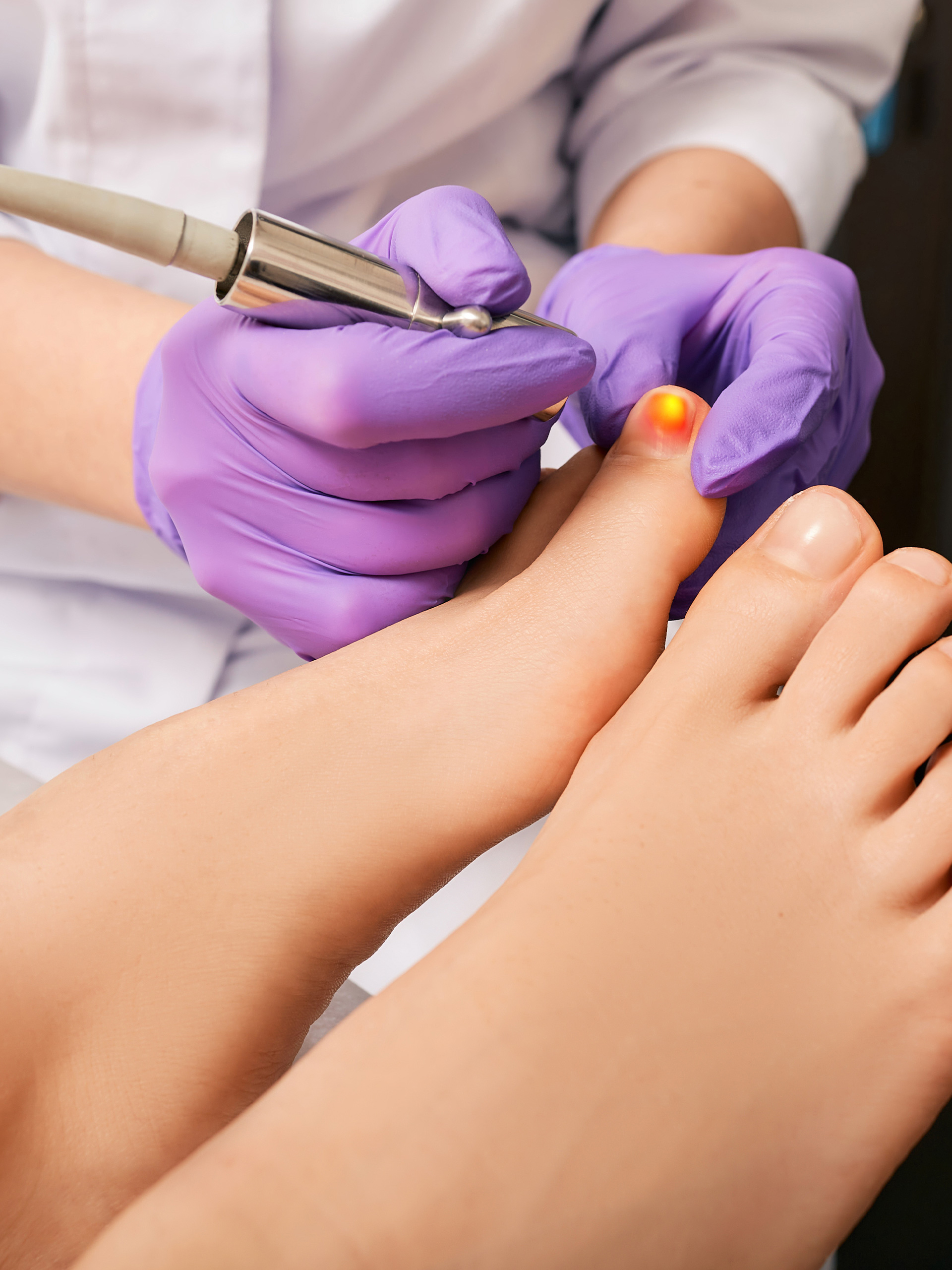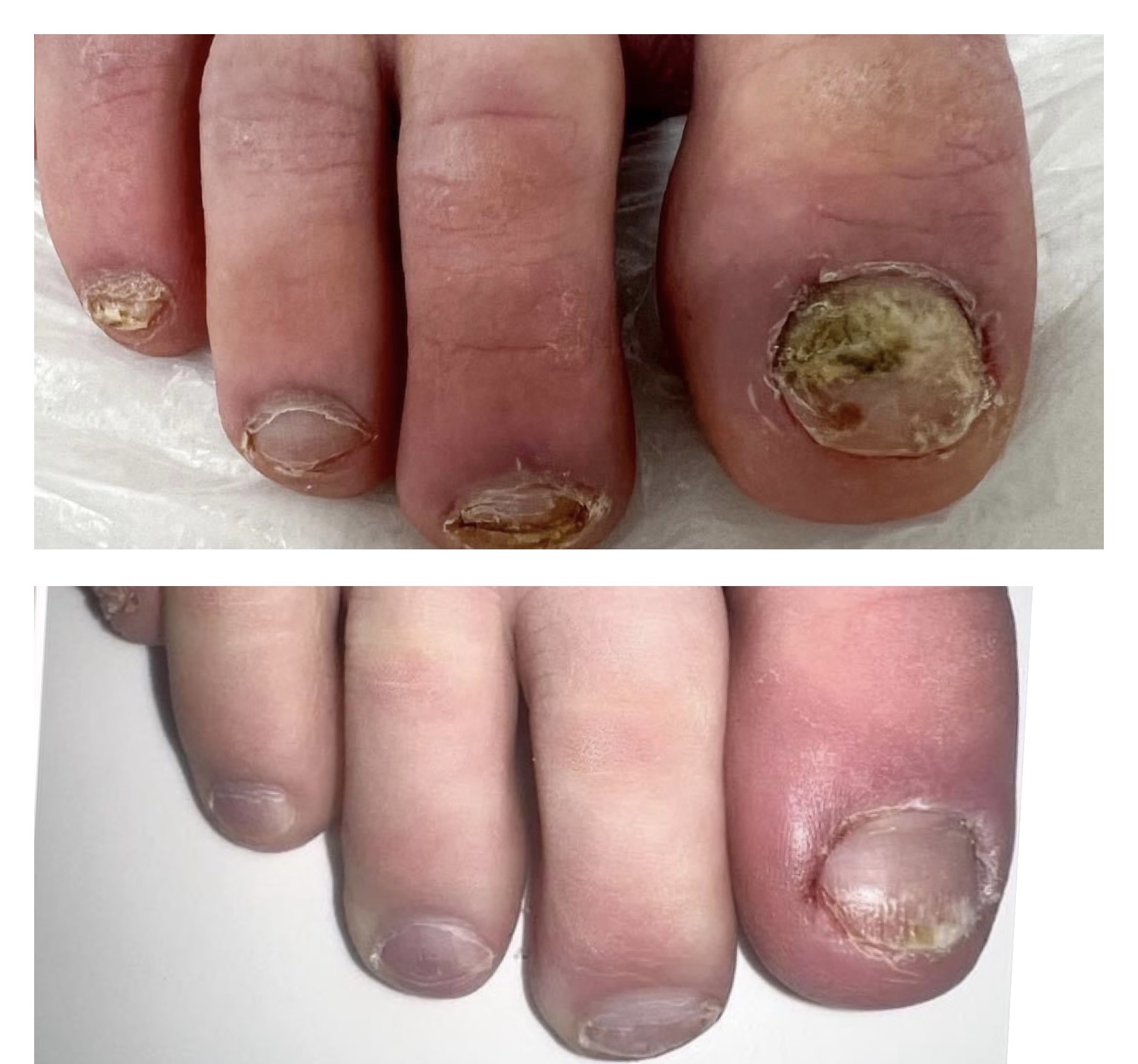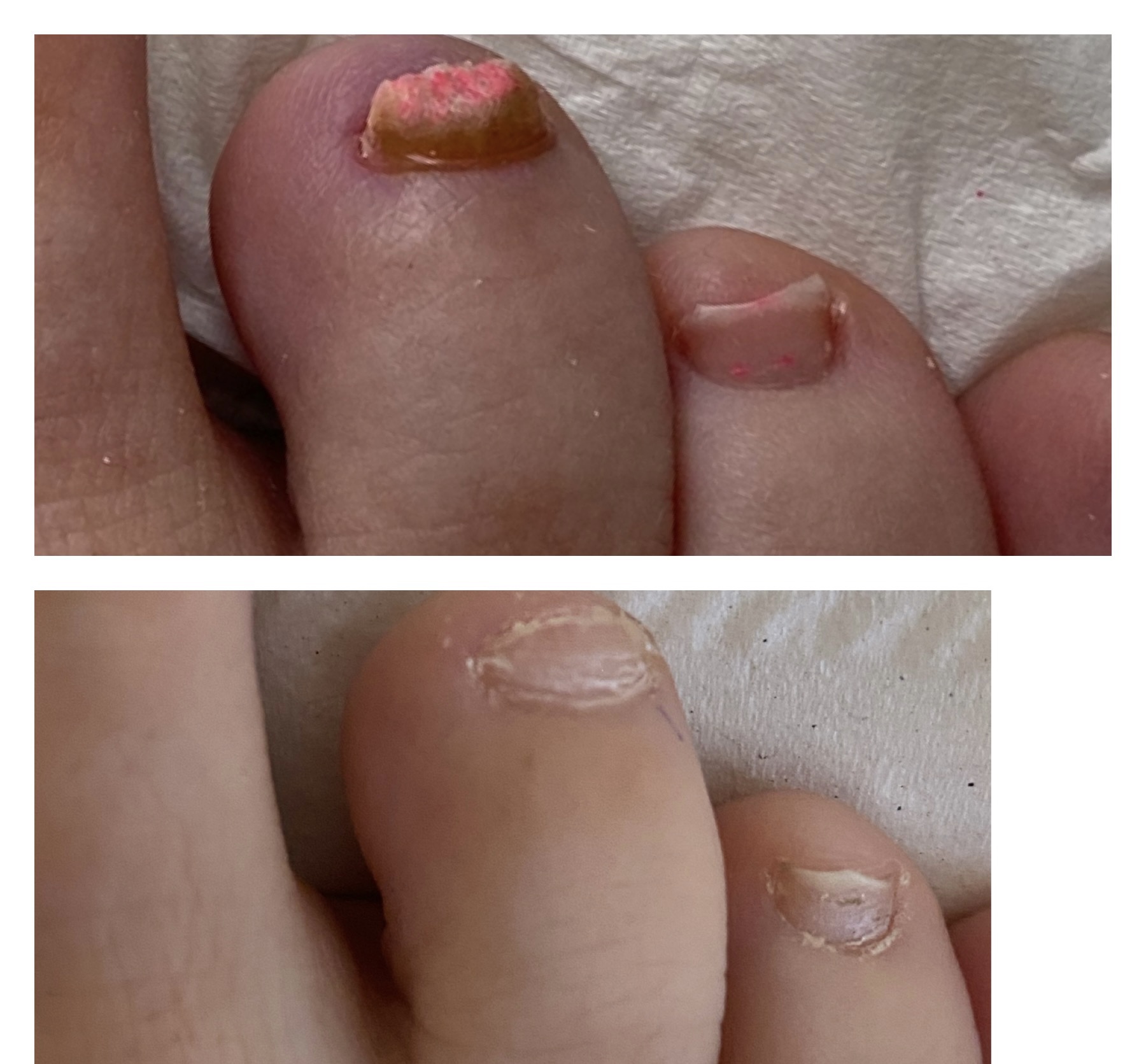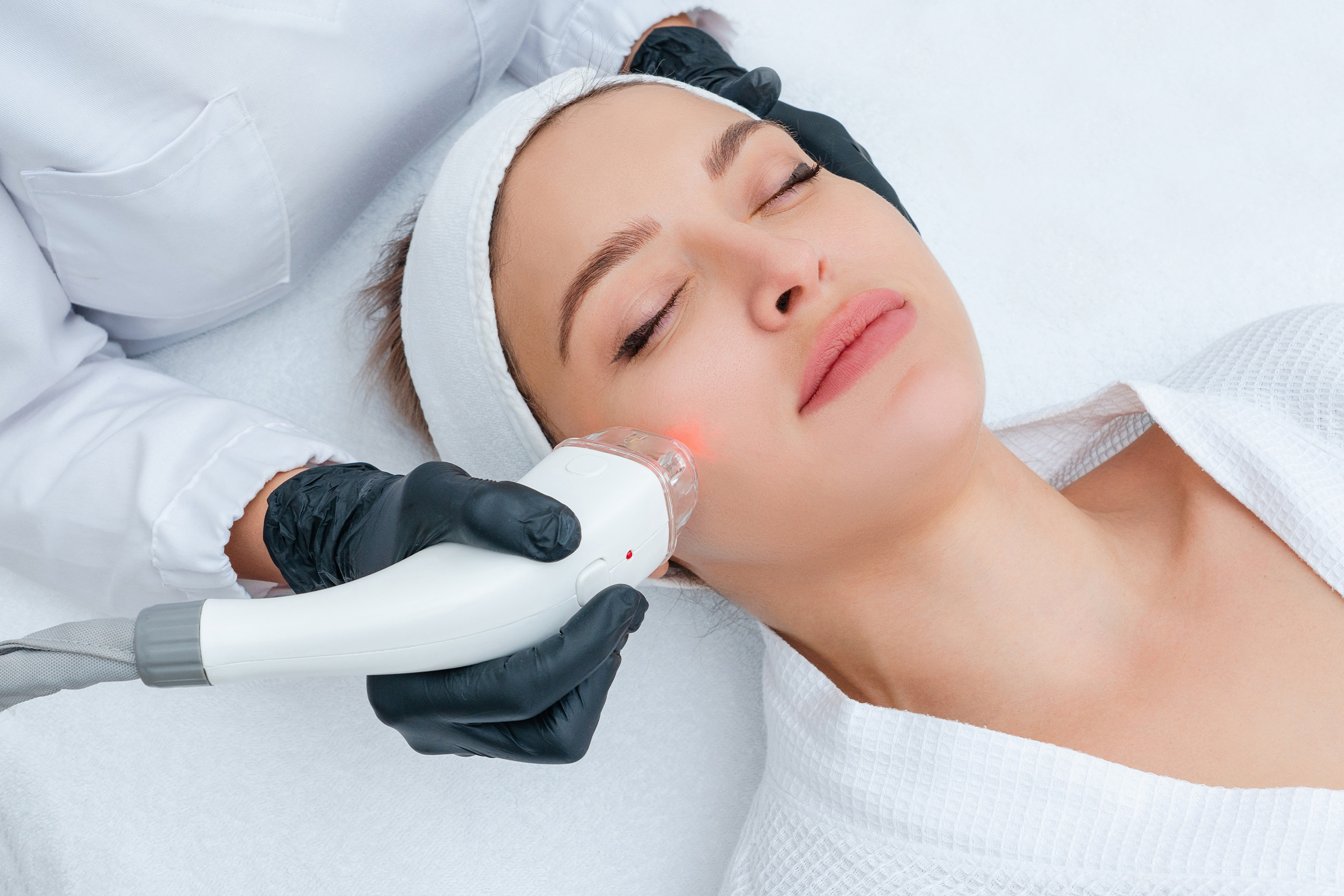
Laser Hair Removal
Laser hair removal is the most effective method of hair removal available, permanently reducing hair growth, leaving you with smoother skin. Suitable for men and women and all skin tones, almost anywhere on the entire body can be treated, including sensitive areas such as the face and bikini line. Unlike other methods such as waxing, depilatory creams and shaving, laser hair removal gives long lasting results, without the ingrown hairs and irritation associated. The hair will also become finer and softer so it’s less visible, and growth will slow down more with each treatment, by the end of your sessions you can expect complete hair removal.
It works by a process called photothermolysis, a direct, precise wavelength of light is released into the hair follicle, which converts to heat, damaging or destroying the bulb. Because the light is precise and travels in one direction, if effectively targets individual hairs instead of the skin, so there’s very little risk of skin damage. To be the most effective, the hair needs to be in the right stage of growth during treatment. Provided the hair is targeted at the right stage of the growth process (anagen phase), hair regrowth slows down or stops, and any potential re-growth slows down or stops, and any potential re-growth you could experience after treatment is much slower, softer and finer.
- Reduces hair growth, permanently – We recommend a minimum of 6-8 sessions depending on the area being treated. If you have the recommended number of treatments for your hair and skin type, you’ll see up to 90%-100% hair reduction. Any hair that does grow back will be much finer and will grow back less frequently, which means smoother skin for longer.
- No more ingrown hairs – You won’t need to shave as frequently, minimising rashes and brittle stubble, and less waxing will also result in fewer ingrown hairs too.
- Money and time saving – The average female spends £6500 on razors and 8 weeks of her life shaving, so laser hair removal is a worthwhile long-term investment!
- Improved skin tone and texture – Repeatedly shaving or waxing an area can cause skin pigmentation and uneven skin tone. Laser hair removal reduces the risk of this happening.
- A positive impact on the planet – The average woman in her lifetime throws away 2400 razors, and every year, approximately 2 billion razors end up in landfill as they cannot be recycled. Switching to laser hair removal will dramatically reduce that negative impact on our planet.
We are pleased to be able to treat any skin type, ranging from very fair to very dark. Our lasers work with most hair and skin combinations, provided that there is enough pigment in the hair.
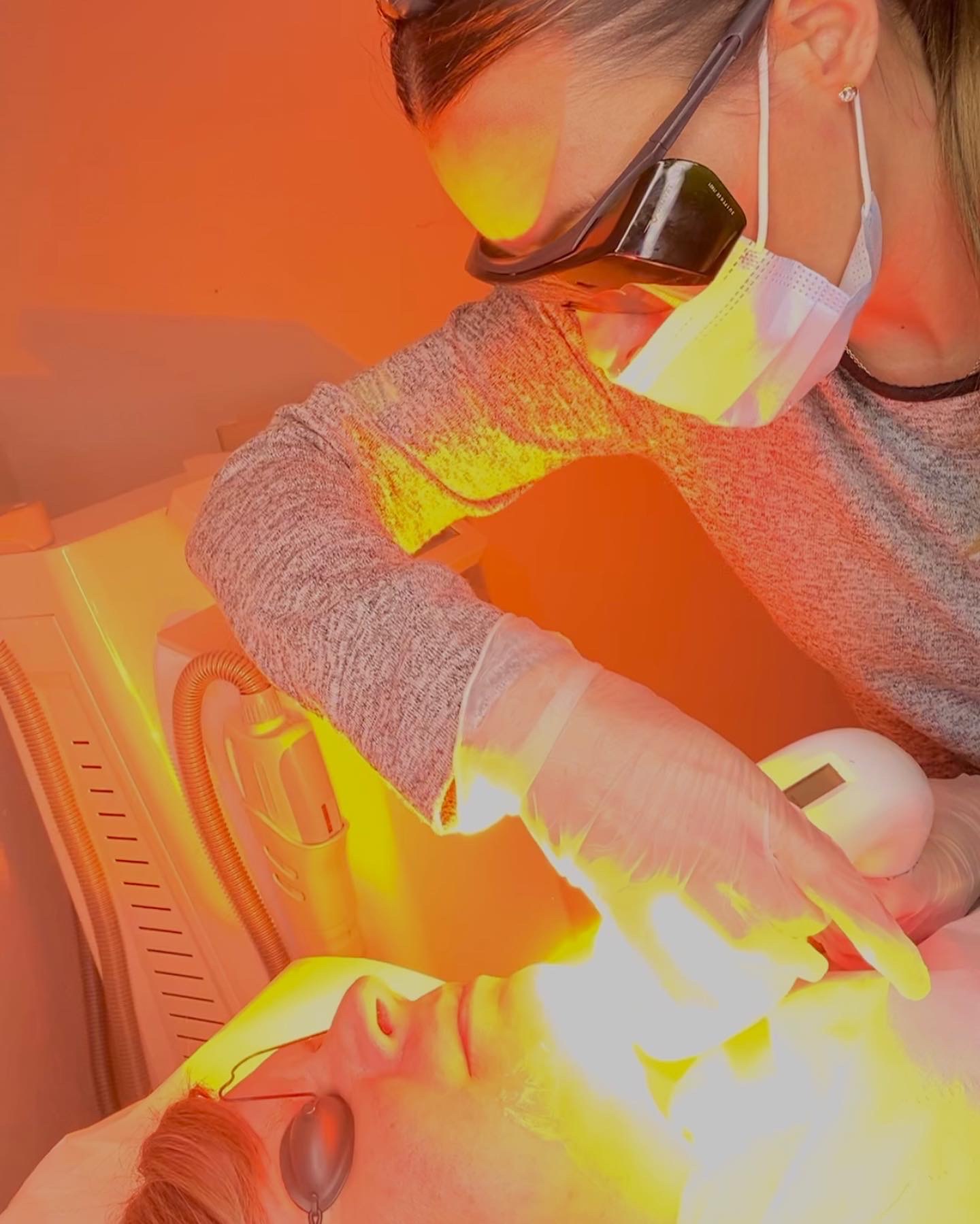
Laser Pigmentation Reduction
Through the natural aging process, overexposure to sunlight, and environmental factors can take a toll on the skin leading to dark spots, freckles and pigmentation.
Changes to the melanin levels in skin can also occur for a variety of other reasons and may be due to hormonal changes, damage to the skin, medication or purely down to genetics.
The first parts of the body to show these signs are usually the face, decolletage, back of the hands and arms, as these area’s receive the most direct sun exposure.
Such conditions are caused by the production of excess melanin, at, Donna Marie Permanent Aesthetics & Laser Clinic, we use specialist medical grade laser equipment, to tailor treatments to effectively remove pigmented areas using the latest technology in a clean and safe environment.
Our laser technology can help treat the following skin conditions:
- Hyperpigmentation treatment/Pigmentation treatment
- Sun damage treatment/sun damage on the face
- Sunspots
- Uneven skin tone on face
- Freckle removal
- Sun damage on decolletage/Neck area
- Sun damage or sunspots on hands or forearms
Please note, IP L is not suitable for hormonal changes such as melasma
Consultation and treatment
The first step of laser pigmentation removal is a consultation and patch test. During the consultation we will assess what type of hyperpigmentation you have and if pigmentation laser treatment is right for you. Providing you are a good candidate for laser, a patch test will be performed, and a follow up session can be scheduled following a negative reaction to the patch test.
Prior to your treatment you should stop all Retinol products, Glycolic acid or other AHA containing products, or Hydroquinone containing products, should stop them 3 days before having laser. Please ensure you do not have a tan on your face, so avoid sunbathing the face for 14 days before your laser treatment and no sunbed use for 14 days before. Also avoid self-tanning products on the face for 7 days before treatment.
- During treatment a gel will be applied to your face and the laser treatment performed, it is a quick and straight forward procedure, which should take no more than 20 minutes. IPL is greatly tolerated although some people report mild discomfort
- Immediately after treatment, there may be some mild redness at the treatment area. For the first 5 days the pigmentated areas will look darker in colour before lightening
- SPF of at least 30 must be worn for 2 weeks after treatment and a full list of aftercare advice will be discussed on the day of treatment
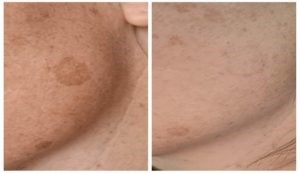
Laser Carbon Peel
This new, revolutionary Carbon Peel, also known as ‘the red-carpet facial’ is a treatment that is suitable for all skin types. The benefits of a carbon peel include reducing large pores, lightening of age spots/pigmentation, reduction of wrinkles and fine lines, an increase in skin elasticity, skin moisture and a glowing complexion.
Cleansing
Carbon has the ability to absorb oil and contaminants from deep within the pores. When the laser is passed over the treatment area it targets and destroys the carbon particles, taking any absorbed material with it.
Exfoliating
As the carbon is targeted by the laser, it blasts away dead skin cells, blackheads and any surface debris effectively exfoliating the area. The result is softer, more radiant skin.
The heat produced by carbon peels has 2 additional benefits. It reduces the P.A bacteria responsible for acne, reduces pore size giving a more even skin tone.
Rejuvenating
Carbon peels also target the deep layers of the skin to stimulate collagen production, which in turn produces firmer, plumper skin, reduces fine lines and wrinkles, and leaves skin feeling tight and glowing.
Acne and Oil Destroying
Allowing for better management of pimples and outbreaks, and it also shrinks sebaceous glands (oil producing glands), resulting in less oil production, and therefore reducing congestion building up in the pores. Treatments can be performed on any part of the body, including the back and chest.
As with all skin treatments carbon peels should be supplemented by a good skin-care routine, and daily use of a high-spectrum sunscreen. Noticeable results can be experienced after a single treatment, but for maximum long-term results we recommend regular treatments,
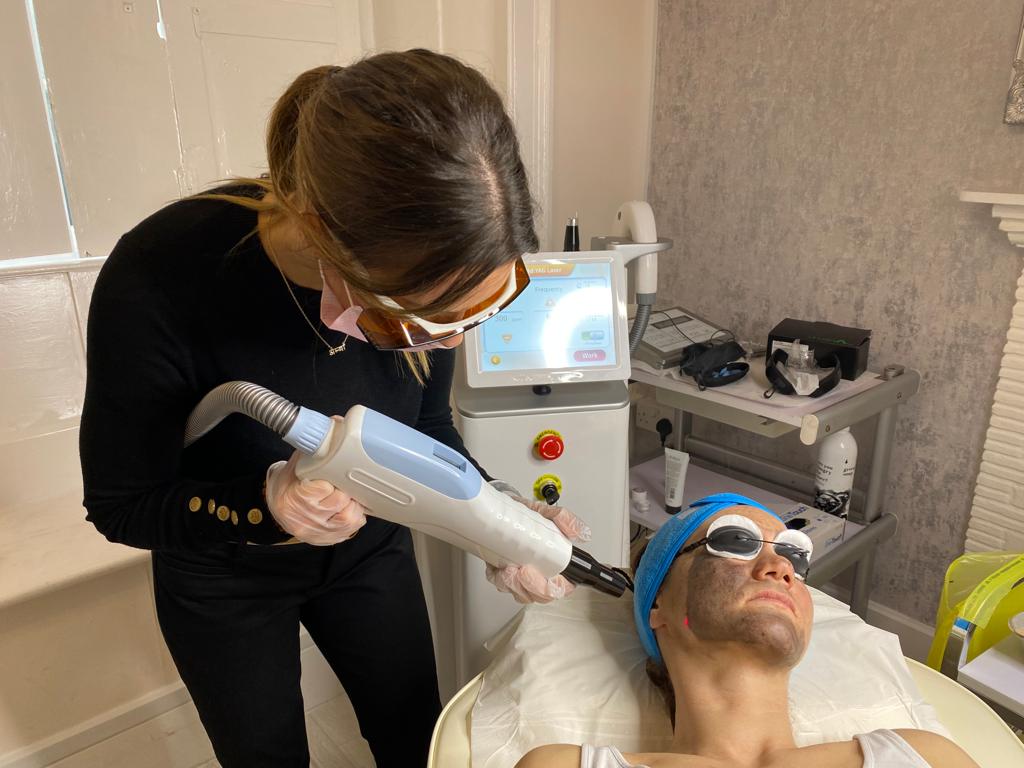
The principle behind the carbon peel treatment is that carbon powder possesses a strong capacity to absorb dirt deep in the pores. The face (and neck) is first coated with carbon nano-particles. Next the laser is used on the skin. The medical-graded laser allows the particles to penetrate deep into pores, shattering the epidermal keratinocytes and dirt. The heat from the laser also enables the carbon powder to be absorbed into the skin, stimulating the skin cells. Regeneration occurs by encouraging growth of collagen and elastic fibres.
The Skin is gently cleansed followed with an application of carbon paste. The laser then zaps the carbon using high intensity pulses of light. This process destroys the dirt and debris on the skin clogged in the pores, refining enlarged pores, reducing oil secretion and helping to remove blackheads and whiteheads. The treatment stimulates the face to produce more collagen which helps reduce fine lines and wrinkles.
It is advised that you use a sun protection cream after treatment with a minimum SP30. A course of 6 sessions is recommended for maximum results and discounts are available for courses.
Laser Acne Treatment
Donna Marie Permanent Cosmetics & Laser Clinic offer the latest laser treatment specifically targeted at acne reducing spots and redness. Acne is very common and can affect both teenagers and adults. Nearly everyone has had acne at some point in their life.
Laser treatment works best for people with mild to moderate acne and is especially suitable for those who have tried the usual treatments with creams and antibiotics with little or no success. Laser treatment is not suitable for severe, cystic, scarring acne. If you have severe acne, you should see your GP or a dermatologist to discuss medication.
We use a 480nm wavelength laser to work with acne. The laser treatment can reduce pustule spots and fade the red marks left behind by the spots but will not remove pits or craters in the skin surface.
The first stage of treatment is a consultation and patch test to ensure you are a good candidate.
For best results laser treatments are usually required at 2-week intervals and most people start to see the results after the 1st or 2nd treatment. A course of 12 is recommended for a 72% reduction of spots or a session four weekly course can help reduce acne by 50%.
Aftercare of your skin is very simple, and any redness usually settles within a day or two. Our specialist will advise you on how to look after your skin.
For the maximum benefit of laser treatment for acne a top up once a year is advised.
PRACTICAL
Before the treatment it is important to avoid sunlight and solariums.
The treatment can only begin on un-tanned skin, since tanned skin may be burnt. It is important that the person being treated does not take photosensitising medication and is not photosensitive. One month before treatment it is prohibited to use microdermabrasion, acid peels, retinol treatments and other treatments, which make the upper skin layer sensitive. Before treatment, a test flash is required, after which you should wait one week to make sure that your skin tolerates light. The patch test flash also allows us to personalise the treatment parameters. After treatment the skin may become slightly red.
Make up can be applied after 24 hours.
During the course of treatments, it is important to avoid sunlight and wear high-SPF sunscreen.
In the first few days after the treatment, swimming pools, saunas and hot baths or showers should be avoided.
Tattoo Removal
Donna Marie Aesthetics & Laser Clinic is your first step to tattoo removal. Providing a safe and effective laser treatment to eradicate unwanted tattoo’s, using the most up to date laser machine. We can treat black, blue, red and green ink tattoos using the Q-Switch System. Unlike salon machines which can only reduce tattoos, our medical laser is powerful enough to fully remove them.
The number of treatments required depends on the size of your tattoo, the quality of the inks used by the tattooist and the depth at which the ink is placed in your skin. Most tattoos take between 6-10 treatments, but some can take longer for complete removal. the sessions will be spaced approximately 8 weeks apart for the best results. If you are looking for a fade down of the tattoo and opting for a cover up, we recommend four sessions.
No. When using the q-switched Nd: Yag laser and following the ‘aftercare instructions’ provided, there is minimal to no scarring, from this procedure. However, in rare cases, those with scarring disorders, such as keloids, have an increased risk of forming a scar.
The laser emits a pulse of light that is preferentially absorbed into certain colours of ink. The light enters the skin at a speed that is too fast to heat the tissues (billionths of a second), instead, it produces a shock wave effect and breaks up the ink particles as something that shouldn’t be there and attacks it. The particles are then removed naturally via the body’s own elimination system.
Tattoo removal causes a certain amount of physical pain and irritation to the area being treated but it is not the same for everyone.
Laser tattoo removal has been likened by come clients to the feeling of having a rubber band snapped on your skin. Others describe it as a rapid succession of pricks. While some say it feels like someone scratching sunburn. Tattoo removal treatments on areas with more fat like the arms and buttocks are generally not as painful as areas where there is less fat or close to a bone like the neck, ankle or finger.
Redness and swelling may occur, this settles within a few days. Some patients may blister, which is quite normal and does not indicate potential scarring. Please refer to the aftercare advice sheet.
The treated area should not be exposed to strong sunlight between sessions without the use of sunblock (SPF 30)
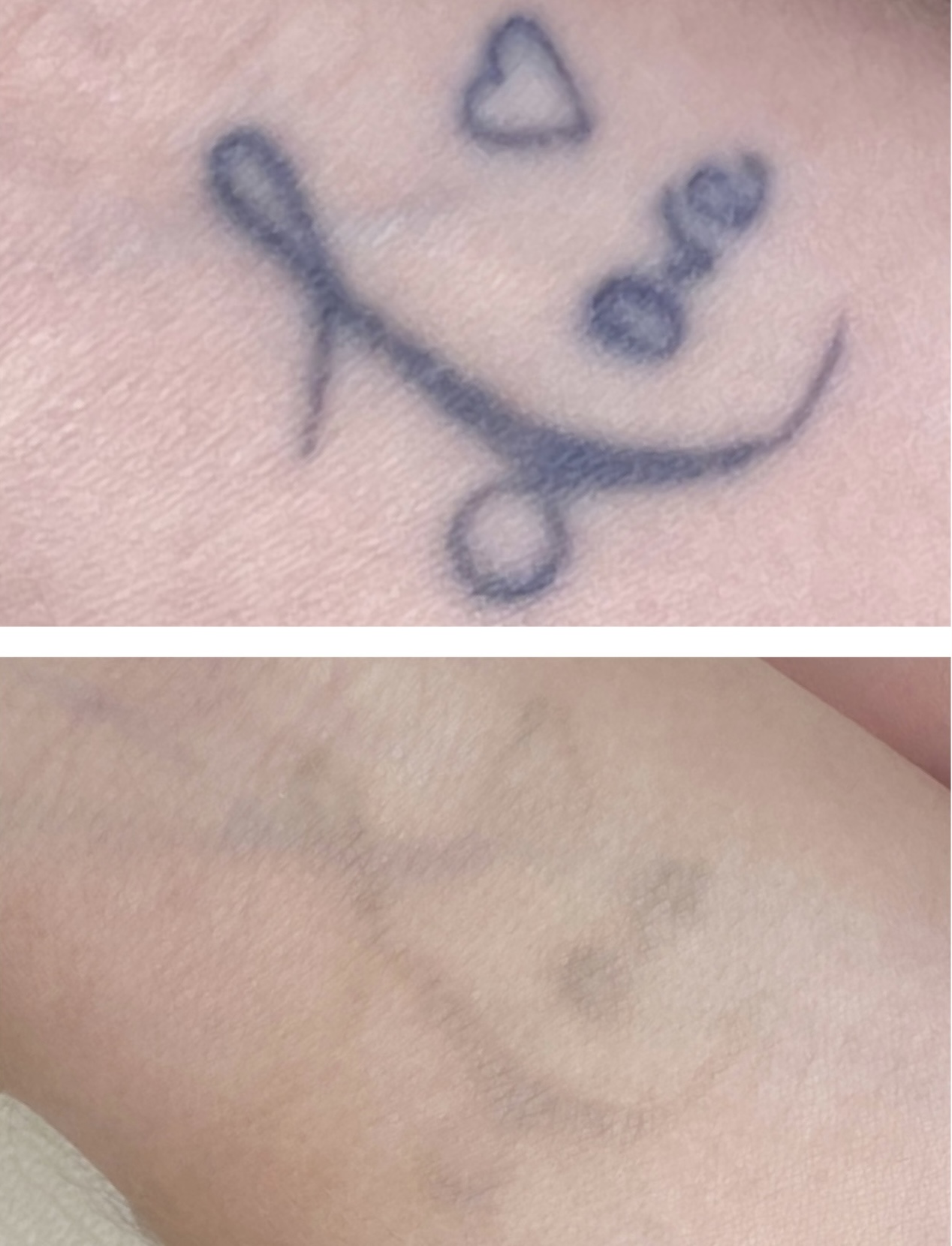
One -two session left to complete removal. No scarring
Radio Frequency Skin Tightening
Radiofrequency (RF) therapy, also called radiofrequency skin tightening, is a nonsurgical method of tightening the skin. The procedure involves using energy waves, to heat the deep layer of skin known as the dermis.
This heat stimulates the production of collagen, collagen is the most common protein in the body. It creates the framework of our skin and gives skin its natural firmness. Radiofrequency Skin Tightening Lift-Shape – lifts, firms, re-models and contours key areas of the face and body.
Face Treatment
As we age skin loses its firmness and plumping structure, due to a natural decrease in collagen and elastin, leaving skin wrinkled and saggy. This can cause a major loss of confidence & low self-esteem, as we notice our appearance changing. At Donna Marie Aesthetics & Laser Clinic, we can help reverse these problems with cutting edge treatments that restore youthful vitality to firm and lift skin.
Radiofrequency Skin Tightening Lift-Shape is a revolutionary new treatment designed to lift, firm, re-model, and contour crucial areas of the face, The treatment radically enhances the appearance of skin texture, decreases fine lines, scars and wrinkles. It lends the face a more youthful appearance and lifted look with no pain and no downtime.
How does it work
Invisible radio wave energy is passed harmlessly and painlessly through the skin gradually heating up the tissues, the collagen fibre that already exists in the skin is altered and the effect produced, is collagen tightening and remodelling. This leads to a noticeably more youthful complexion and appearance.
Body Treatment
Radiofrequency Skin Tightening for the face has been incredibly popular with our clients and in addition to this treatment, we are now offering the same proven technology for the body. Radiofrequency Skin Tightening for the body has an excellent track record and offers proven results in reducing fat, contouring curves and improving cellulite. It is also effective at targeting stretch marks and post-pregnancy scars. it will leave you with firmer. tighter skin.
Radiofrequency longer wavelengths are a form of energy like radio waves. They invisibly and painlessly penetrate the skin, passing through deep into the fat layer, gradually heating the tissues. As a result, the fat cells are disrupted & the body encouraged to reabsorb them. The existing collagen under the skin is transformed, encouraging the production of new collagen and elastin cells.
Benefits of Radio Frequency
- Improve and visibly reduce cellulite
- Firming of the skin
- Reduction of fat
- Improve the look of stretch marks and scars
- Lift and Contour
SHR Pain Free Hair Removal
SHR combines laser technology and pulse light to achieve almost painless results for the removal of most types of hair and is safe on all skin types. SHR is different from the traditional IPL and laser as it targets the hair germ cells and blood supply that feeds it. It does not rely solely on pigment of the hair to effectively destroy the targeted hair.
New research has shown that a slower, longer heating process is more effective for permanent hair reduction than high and short levels of energy.
The number of sessions will vary depending on the hair follicle cycle at the start of treatment. Most people will require six sessions. Some people will see a 70% hair loss reduction after just four sessions.
For best results, on average we recommend 6 to 10 treatments. This will allow hairs to be disabled effectively during the active growth phase. After completing a treatment course, if required, we recommend maintenance touch ups to be performed once or twice a year. People suffer from hormone imbalance may require more treatments.
In order for the treatment to be as successful as possible there are a few requirements to take on board:
- Please ensure the area to be treated is free from ALL topical solutions
- Shaving is required 2-12 hours prior any sooner can result in heightened sensitivity during the process
- Avoid exposure to the sun for a minimum of three days before treatment whilst tanned skin is absolutely fine to work with, the tan cannot be active in order to achieve maximum results
- Cease use of tanning creams two weeks before treatment
- Avoid bleaching, plucking waxing, epilation and any other forms of hair removal for 4 weeks prior
- Do not use essential oils 48 hours prior
- Depilatory creams should be avoided 1 week before treatment commences
- Cold sore medication can be taken five days before and five days after treatment
- Should you be on antibiotics it is recommended to leave a two-week gap between taking them and starting treatment
Actively growing hair that’s been treated with SHR should not grow back. Once a hair follicle is damaged, it cannot grow hair. However, hair follicles that were not in the active growth phase will need to be treated. It’s also not unusual for some patients to have a touch-up two years after initial treatment due to hormonal changes.
This depends on the area of the body to be treated. The duration of the treatment can vary between a few minutes for the upper lip, a half hour for the lower legs up to more than an hour for the whole body. The SHR treatment time with our medical grade machine takes less time than with our IPL technology.
Depending on skin type and sensitiveness of the skin, some light skin redness (erythema) or slight swelling can be experienced. These are normal reactions which show that the treatment was effective and disappear after a short while.
The taking of certain medicines which cause photo-allergic and photo-toxic reactions must be clarified beforehand. Full Consultations and patch tests are performed before a first treatment.
Tattoos must be covered carefully otherwise there is a risk that they become damaged.
Fungal Nail Laser Treatment
Fungal nail infections (onychomycosis) are very common affecting up to one in ten of the UK population. Toenail fungus is an infection underneath the surface of the nail caused by fungi.
When the tiny organisms take hold, the nail often becomes darker in colour and smells foul. Debris may collect beneath the nail plate, white marks frequently appear on the nail plate, and the infection is capable of spreading to other toenails, the skin, or even the fingernails. If ignored, the infection can spread and possibly impair your ability to work or even walk. The resulting thicker nails are difficult to trim and make walking painful when wearing shoes. Onychomycosis can also be accompanied by a secondary bacterial or yeast infection in or about the nail plate.
Some prescription medications have side effects and therefore are not always the best treatment option. Another option is surgery to remove the nail; this is not a popular option either. Laser therapy to treat the disease is gaining popularity as a means to achieve clear, healthy nails.
Medicine has benefited significantly from the use of lasers. Specifically, within dermatology, advances in laser technology have allowed the development of lasers to target fungal cells. Over the past 5 years the advances have been significant initially using heat delivered with the laser and its infra-red 1064nm beam.
Fungus us contained within the nail complex and the lasers can target fungal cells directly without the risks involved when oral medication is taken, or the long period of time required when applying topical medicines that are not capable of penetrating the nail bed.
Lasers have no detrimental effect on healthy skin or nail and require no anaesthetic. They are not surgical and there is no recovery period or effect on activity after treatment.
During the Nail Fungus Laser Treatment, a laser beam will be slowly directed across the nail bed. The laser beam will generate heat beneath the nail and within the underlying fungal colony. You will feel a warm sensation during the procedure which lasts 1 minute to 2 minutes per toenail.
There may be a slight pain sensation as a result of the heating effect of the laser treatment.
- The procedure is safe
- No anaesthesia is required
- No side effects
- There is no visible harm to the treated nail or adjacent skin. Socks and shoes can be worn immediately after the procedure. Nail polish can be applied after treatment. There is no “recovery” period after the procedure.
Although the fungus is effectively killed by the laser at the time of treatment, the toenail must grow out. The healthy toenail typically grows out at a rate of about 1mm per month. If the nail is only 1/4 involved, it will probably look clear and healthy in about 3-4 months. If the toenail is 50% involved, it will probably take 5-6 months to see a completely clear and healthy-appearing toenail. A toenail that is 100% infected will take almost a year to regrow into a healthy nail after the laser procedure. The full treatment will be completed within two sessions one month apart.
Depending on skin type and sensitiveness of the skin, some light skin redness (erythema) or slight swelling can be experienced. These are normal reactions which show that the treatment was effective and disappear after a short while.
The taking of certain medicines which cause photo-allergic and photo-toxic reactions must be clarified beforehand. Full Consultations and patch tests are performed before a first treatment.
Tattoos must be covered carefully otherwise there is a risk that they become damaged.

